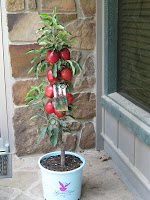Raise a toast to this drought- and heat- tolerant redbud with Merlot-colored leaves. Merlot Redbud (PPAF) is the preferred vintage for those gardeners in hotter, drier zones (U.S.D.A Zones 6 – 9) looking for a small ornamental tree with dark foliage. A cross between Cercis canadensis 'Forest Pansy' and Cercis canadensis var. texensis, Merlot Redbud is much more drought- and heat- tolerant than eastern redbud trees and has appealing shiny wine-red foliage that laugh at heat.
At 12’ x 15’ Merlot is the perfect tree for small yards. Overall the small ornamental tree has as a semi-upright vase-shaped growth habit. The plant is tighter and denser than Cercis ‘Forest Pansy’.
Mature trees flower heavily with strong, bright magenta-pink flowers on bare branches. They are self-cleaning and have a low seed set. Thus the homeowner or landscaper enjoys a heavy bloom but the seed pods tend to drop early before ripening and turning brown, and don’t hang on the tree. These flowers are attractive to bees, butterflies and nectar-loving birds.
The name ‘Merlot’ means ‘young blackbird’ in French, after the dark maroon-black color of both the varietal grape from Burgundy and the leaf of this redbud, a ‘grand cru’ among Cercis cultivars.
Statistics Chart for Merlot Redbud (PPAF), Cercis canadensis var. texensis x Cercis canadensis 'Forest Pansy'
| Plant Category: | Deciduous flowering tree |
| Mature Height: | 12 feet |
| Mature Spread: | 15 feet |
| Mature Form: | Semi-upright vase, shaped habit. The perfect tree for small yards. |
| Growth Rate: | Vigorous |
| Sun Exposure: | Best grown in full sun |
| Heat Tolerance: | Great tree for those gardeners in hotter zones looking for a darker foliage small flowering tree. |
| Soil Moisture: | Well-drained soil, drought resistant tree due to texensis parentage |
| Soil Type: | Loamy, Sandy, or Clay; wide range |
| Flower Color: | Strong, bright pink flowers |
| Bloom Time: | Flowers on bare branches in Early Spring |
| Seed Pods: | Merlot is self-cleaning and has a low seed set. The homeowner or landscaper enjoys a heavy bloom but the seed pods tend to drop early before ripening and turning brown, and don’t hang on the tree. |
| Summer Color: | Deciduous, small rounded glossy dark purple leaves, the color of Merlot wine. |
| Fall Color: | Red-Burgundy color holds in fall |
| pH Level: | 5.5 – 7.5 |
| Zones: | 6 – 9 (-10 degrees F or 23 Degrees C), well suited for hot climates |
| Heredity: | U.S., Breeder Dr. Dennis Werner, through PlantHaven, Inc., CA on behalf of North Carolina State University |
When performance counts, use Garden Debut® introductions
Photo credit: Flowers by PittState.edu




















